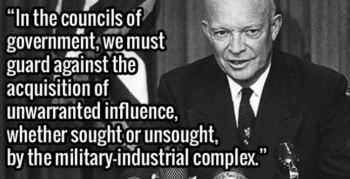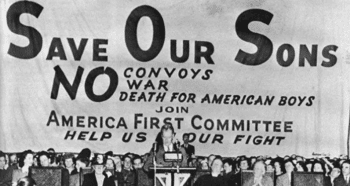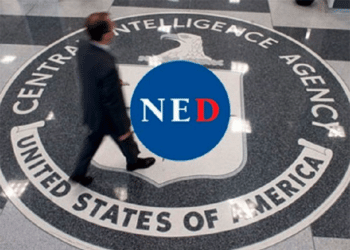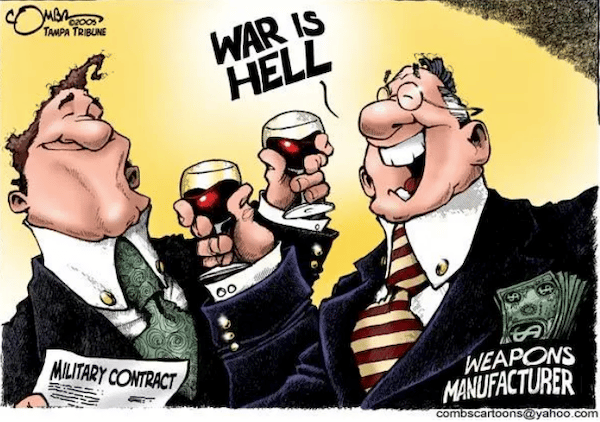
[Source: amazon.com]
Only small hardy bands by comparison have taken to the streets to protest record military budgets—approaching $1 trillion under Joe Biden—or the illegal bombing of Syria, expansion of U.S. troops in Africa, provision of $20 billion in U.S. military aid to Ukraine, and military provocations directed against China.
Joan Roelofs’1 new book The Trillion Dollar Silencer: Why There Is So Little Anti-War Protest in the United States (Atlanta: Clarity Press, 2022), starts with an important question: “Why is there so much acceptance and so little protest against our government’s illegal and immoral wars and other military operations?”
Her answer is simple and convincing: Money.
While successful propaganda, fear and distraction are important, the military-industrial complex that Dwight Eisenhower warned about in his Farewell Address in 1961 has penetrated so deeply into American life that much of the American public has essentially bought into acquiescence.
Roelofs writes that “the economic impact of the military-industrial complex is a highly effective silencer.”

[Source: illuminatirex.com]
Millions of American workers find jobs with military contractors or their subsidiaries, which finance scholarships and internships for college students who have no knowledge of the anti-Vietnam War protests that once roiled their campuses.
According to Roelofs the triumph of military Keynesianism in the U.S. is evident by the fact that military spending consumes half of the federal government’s discretionary budget.

Mr. Military-Industrial Complex: Now retired Senator James Inhofe (R-OK), who supported huge military budgets as Chairman of the Senate Armed Services Committee for many years, owned stock in Raytheon. Inhofe is revered in some parts of Oklahoma for securing generous financing for Oklahoma’s military bases. [Source: taskandpurpose.com]
Many in the middle class benefit from weapons manufacturers stocks in their mutual fund portfolios. In Roelofs’ home state of New Hampshire, the F-35 program supports 55 suppliers—35 of which are small businesses—and more than 900 direct jobs, many of them located at BAE Systems in Nashua, which Money Magazine twice deemed the “best place to live in the U.S.”
According to Business Review, the F-35 program “generates over $481 million in economic impact in the state.”
In May 2022, BAE Systems—which manufactures the M777 howitzer, a most “lethal weapon” that has been used to shell the Donbas in eastern Ukraine—opened a new plant in Manchester whose focus was on the development of electronic warfare; it was slated to employ hundreds of people.

National Guard at Boy Scout Jamboree. [Source: Photo courtesy of Joan Roelofs]
Endearing Itself to the Public
Military industry always gets its way through massive campaign contributions to politicians from both major political parties and extensive lobbying. Congressmen and women are well aware of the benefits to their districts and often hold weapons industry stock.
The industry burnishes its image through extensive philanthropic endeavors and support for many civic institutions, especially those benefiting youth and minorities. Among them is the Boy Scouts.
The military further sponsors video games, sports events, parades and movies that glorify and normalize militarism. Roelefs writes that “extremely well-funded recruitment efforts in schools include ‘fun simulations’ of warfare.”
Military-Industrial-Academic Complex

Admiral William McRaven delivers the commencement address at the University of Texas, 2014. [Source: abc13.com]
The Human Terrain System program in 2007 harked back to the Cold War-era U.S. Army Project Camelot in employing social scientists to obtain anthropologic and ethnographic data in Iraq and Afghanistan to assist in U.S. counterinsurgency operations.
Presidents of major universities have increasingly come from a military or CIA background. Former Defense Secretary and CIA Director Robert Gates, as an example, served as President of Texas A&M University, while Admiral William McRaven, who oversaw the Joint Special Operations Command (JSOC) which specialized in assassination, served as Chancellor of the University of Texas.
Whereas at one time, faculty were ashamed to admit that they received research funding from a military agency, now only 12% said they would feel any stigma. And professors at even supposedly liberal colleges and universities have lost their positions because of opposition to U.S. foreign policy.

[Source: allthatsinteresting.com]
Rise and Fall of Anti-War Movements
According to Roelofs, while the military has always been part of U.S. culture, the 19th century saw the development of a respectable pacifist counter-culture that was driven in part by the strength of enlightenment thought and radical Christianity.
Henry David Thoreau became famous for refusing to pay his taxes during the 1846-1848 Mexican-American War—which was also strongly opposed by a young Abraham Lincoln.
A sharp turn occurred during World War I, when pacifists were demonized in a government-orchestrated propaganda campaign and jailed.

Anti-Vietnam War protest in Los Angeles in 1966. [Source: calisphere.org]
In the 1930s, the America First Committee emerged as the largest anti-war movement in U.S. history, but dissolved immediately after Pearl Harbor and there were few if any protests against the Dresden and Tokyo firebombing campaigns and dropping of the two atomic bombs, or against the Korean War.
World War II and the Cold War brought universities, and many industries and civilian institutions, into partnership with the burgeoning warfare state. One of the most important of the New Deal programs, the Tennessee Valley Authority (TVA) became instrumental in enabling large-scale nuclear weapons production by damming the rivers near the Oak Ridge National laboratories in East Tennessee.
With a Cold War mentality deeply ingrained, protests were slow to develop against the Vietnam War and the anti-war protest in the late 1960s proved to be short-lived. The government abolished the draft and found new ways to wage war with a limited American footprint—so the sons and daughters of the middle-class would never have to fight.

[Source: sott.net]
William D. Hartung, a fellow at the non-interventionist Quincey Institute for Responsible Statecraft, wrote that “military contractors are riding high [today], and Ukraine just gives them another argument as to why things need to continue onwards and upwards.”2
Cooptation of the 1960s’ Left
Roelofs emphasizes how in the wake of the 1960s protest movement, corporate foundations began more aggressively funding groups that advocated societal reforms without threatening the U.S. Empire or capitalism.
A 1969 exposé in Ramparts magazine, written by David Horowitz, uncovered that the CIA used at least 46 foundations to funnel money to organizations whose main purpose was to defuse anti-war protest and co opt or divide the political left in the U.S.

Two U.S. army veterans, Fred Downs and Artie McAuley, show off new prosthetic arms developed by DARPA. [Source: rt.com]
Related to this was the sponsorship of monitoring organizations that framed human rights abuses as “deviations” committed by bad people, without connection to foreign corporations or U.S. military training or imperial designs. A key effect was to channel activist energies, especially of youth, into pro-interventionist groups like Free Tibet and Save Darfur, which had a strong presence on college campuses at the time that the War on Terror and its associated atrocities were being expanded.
War profiteers like Bechtel, which has received massive contracts to build U.S. military bases abroad, have become increasingly savvy in setting up their own foundations designed to defuse antiwar protest and neuter the political left. The organizations they support may do some good but have abandoned efforts to link environmental destruction and the crisis in public education with bloated military spending, while never questioning the prevailing political-economic order.
According to Roelofs, Corporate America additionally coopted the 1960s’ New Left movement, which advocated for a fundamental reorientation of U.S. foreign policy, by promoting more minority hires and presenting women’s involvement in the military and with military contractors as a triumph of the feminist movement.
The Defense Advanced Research Projects Agency (DARPA)—which produces ghastly new weapons systems straight out of science fiction novels—created a fake humanitarian image, meanwhile, by emphasizing its development of scientific solutions for helping wounded veterans, including through the manufacture of cutting-edge prosthetic devices.
Suffering the Consequences

Vera Kistiakowsky [Source: physics.mit.edu]
In a 1989 volume of The Annals of the American Academy of Political and Social Science devoted to “universities and the military,” MIT Physics professor Vera Kistiakowsky, one of the country’s outstanding scientists of the 20th century, wrote that “Pentagon funding of university research has no benefits. Preferential funding of weapons has had its economic consequences, witnessed by our deteriorating civilian industrial infrastructure, our negative balance of trade, and our mounting deficit. We have not invested in civilian research at a level adequate to these pressing problems, and will continue to suffer the consequences until we do.”
These remarks seem even more prophetic and relevant in 2023. The trillion dollar silencer may backfire if the problems described by Kistiakowsky continue to intensify.

